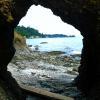February 2, 2015 - 23:16

Looking back over some of readings, there are many ways to begin developing an “ecological curriculum.” My responses to the theory we read were varied. While I appreciated Morton’s attempts, an ecological curriculum isn’t just open, engaged and infinite, it has to be grounded. Maniates “Teaching for Turbulence” perhaps struck me the most because above the others he focused on actual actions that could be taken, and his metaphor seemed helpful. I’ve started thinking through how I might shape something ecologically.
The first idea I have been musing over may work because of its simplicity: ecological thought is like painting with watercolors. An art teacher in high school once said that painting with watercolors is like working with teenagers; I guess I’ve swapped it around a bit. The first step to designing an ecological environment is accepting the limitations of your control. If the world is relentlessly interconnected and expanding, the colors might not flow the way you expect. That doesn’t mean that you can’t or shouldn’t define certain parameters so that something cohesive can emerge. You can use certain colors or brush strokes, or in the real world, certain words or actions. Still, successful teaching or painting depends on accepting two things: that a moment may not go the way you expect it to, and that despite that, we still have to ability to make it mean something. The nature of the paints themselves are the nature of universe, of endless connections and possibilities of thought and reality. You as the painter are the mechanism that grounds it. You make solid choices in the present that decides what the final product will look like.
This metaphor/image is still taking shape, and I'm working on ways to expand it.
